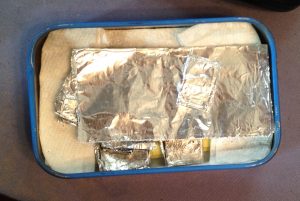
This is an Opinion piece from our friends at the think tank, Americans for Limited Government. They argue that a Southern border wall would deter illegal immigrants, and also reduce the amount of opioids, especially heroin, being smuggled into the country. Most American communities are aware of the blight of cheap heroin, it is marked in the obituary columns of our local newspapers and the headstones with dates too close together, and few would argue that decriminalization of these powerful drugs is in the nation’s interests.
By Printus LeBlanc
The U.S. is in the middle of an opioid epidemic. There were more than 50,000 drug overdose deaths in 2015. Over 32,000 of those deaths were related to opioid products, heroin and prescription medications. Congress is stalling on a border wall that would help ease this burden.
During the presidential campaign opioid addiction became a central theme. Chris Christie and Donald Trump both addressed the issue early in their runs for the White House. But how was it that stemming the flow of illegal narcotics that have caused so much harm become such a political issue?
The narcotic heroin and prescriptions pain medications such as fentanyl, OxyContin, Vicodin, and morphine are a class of drugs known as opioids. The drugs are used for pain relief, but also produce a euphoric sensation. The National Institute of Health states “When heroin, oxycodone, or any other opiate travels through the bloodstream to the brain, the chemicals attach to specialized proteins, called mu opioid receptors, on the surfaces of opiate-sensitive neurons (brain cells). The linkage of these chemicals with the receptors triggers the same biochemical brain processes that reward people with feelings of pleasure when they engage in activities that promote basic life functions, such as eating and sex.”
The Center for Disease Control (CDC) states the sales of prescription opioids have nearly quadrupled from 1999 to 2014. However, with the rise of prescriptions there should be a rise in the amount of pain Americans report, that is not the case. In the same time frame prescription painkillers rose by a factor of four, there was no change in pain reported by Americans, pointing to an overprescription problem.
How large is the opioid epidemic? According to the Department of Health and Human Services (HHS), on average more than 650,000 prescriptions are filled every day for opioids in the U.S.
The current crisis can be traced to the birth of OxyContin, aka Oxy. Oxy was introduced to the market by Purdue Pharma in 1996. Wanting to boost sales, Purdue put together a high-end marketing plan with videos and brochures to make Oxy seem safe for everyday use. The campaign was targeted at doctors to help patients with “pain” with a drug that wasn’t addictive. The campaign itself would come under fire years later by the Government Accountability Office (GAO). In 2003 the GAO stated, “Purdue has been cited twice by FDA for using potentially false or misleading medical journal advertisements for OxyContin that violated the Federal Food, Drug and Cosmetic Act (FD&C Act), including one advertisement that failed to include warnings about the potentially fatal risks associated with OxyContin use.”
Purdue Pharma and three executives would eventually plead guilty to charges they misled regulators, doctors, and patients about the drug’s risk of addiction and abuse potential. The company would agree to pay $600 million in fines and fees. A pittance, when you consider Oxy was bringing in over $1 billion per year since 2000.
Once the doctor stops prescribing the opioid painkillers, what is an addicted person to do? They go to street for illegal Oxy, or they make the switch to the cheaper alternative, heroin. Enter the drug cartels.
Drug cartels obey the basic laws of economics. They saw the demand for heroin and counterfeit prescription painkillers, and decided to fill the supply side of the equation.
In 2007 the National Drug Threat Assessment, stated heroin production had been decreasing reaching a low of 8 metric tons in 2005. Since that time, production has risen 1,000 percent to 80 metric tons in 2015, according to the 2016 National Drug Threat Assessment.
The change has made Mexico the world’s third largest producer of heroin, and Mexican heroin now controls over 50 percent of the market share. Aside from dominating the market share, most of the heroin from Colombia and South-East Asia must pass through Mexican cartels before getting to the U.S.
Mexico’s former Public Safety Secretary Genaro Garcia Luna recently said cartels send $64 billion worth of drugs into the US every year.
Americans for Limited Government President Rick Manning said that means it is time to build the wall, stating, “The free flow of drugs and drug gang members across the Mexican border is fueling tragedy across the nation, from violence in our inner cities to opioid addiction in our rural and suburban areas. It is incumbent on our leaders to secure our nation, and build the wall between those who would poison our people.”
The U.S. has a heroin epidemic killing 50,000 people a year, and an open border with the world’s third largest producer of heroin. Don’t you think a wall or wall-like object would help stem the flow of illegal drugs? It is time for Congress to fund the border wall.
Not only did they run on securing the border during their campaigns, it has national security issues. The wall would help stem the flow of illegal immigration, illegal drugs, and other contraband. What is wrong with that?
Printus LeBlanc is a contributing reporter at Americans for Limited Government.
